History of Photography
From Petzval’s Sum to Abbe’s Number
A Brief History of Early Photographic Lenses
I’m kind of a history buff, and those of you who are may enjoy this. Even those of you who aren’t into the history of photography may like this because the early lenses were attempts (actually amazingly good attempts) to solve the same problems we want solved with our lenses today: wide apertures and sharp images free of distortion. Or maybe because it’s always fun to realize the hallowed founding fathers of photography were pretty much a bunch of name-calling back-stabbers that would make appropriate characters in a current daytime drama. And that even in the middle 1800s the two driving forces in improving technology were pretty much the same two in place today: the military and pornography.
Lenses Before Cameras
Lens making was a big business long before Niepce took the first photograph in the 1820s. Spectacles had been in widespread use for over a century, microscopes and telescopes had been around much longer.
More directly related to photography, however, was the widespread use of the camera obscura (literally meaning dark chamber). For centuries it had been known that a pinhole in the wall of a dark room would project a view of the scene outside onto the opposite wall. By the 1700s, the camera obscura was often a wooden box that used a simple lens and mirror to project the image onto a ground glass plate. Those of limited artistic abilities would place a sheet of tracing paper over the glass and sketch or paint the image obtained, working under a canvas cover.
Figure 1: A Camera Obscura
A simple biconvex lens was originally used to concentrate the light of these camera obscuras, but the field curvature of such a lens is so severe that only the center of the image is in focus. In 1812, W. H. Wollaston found that a meniscus shaped lens provided a much flatter field. Wollaston was already filthy rich from discovering the process for refining platinum, inventing the camera lucida, and the goniometer among other things, so he didn’t bother patenting his meniscus lens and any lensmaker could produce and sell them. Wollaston’s meniscus lens, therefore, became the lens of choice for the camera obscura of the time.
![]()
![]()
Figure 2: A biconvex lens (left) and meniscus convex lens (right)
Wollaston’s lens demonstrated that bending the shape of the lens can correct field curvature to some degree.
The First Cameras
Wollaston’s meniscus, while fine for a camera obscura, suffered from horrid longitudinal chromatic aberration: it bent different wavelengths of light a different amount. This wasn’t too big a deal when tracing an image on a glass plate, but made it very difficult to focus a photographic image properly. The very first photographic image, taken by Joseph Niepce in 1822 or 1826, used a camera obscura with a Wollaston lens, but with an exposure time of 8 hours, focus was not really an issue.
Niepce and his later partner, Daugerre, both bought lenses from Charles Chevalier in Paris (in fact, Chevalier introduced them). Chevalier’s firm was known for the fine achromatic doublet lenses they made for telescopes and microscopes. Chevalier originally found that reversed telescope achromatic doublets produced an acceptable image with much less chromatic aberration. In 1839 he combined the two ideas: producing an achromatic doublet with a slightly meniscus shape, and the resulting lens, known as the French Landscape Lens, was sold with almost every early Daugerrotype camera.
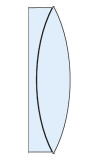
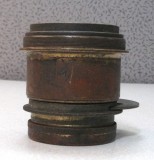
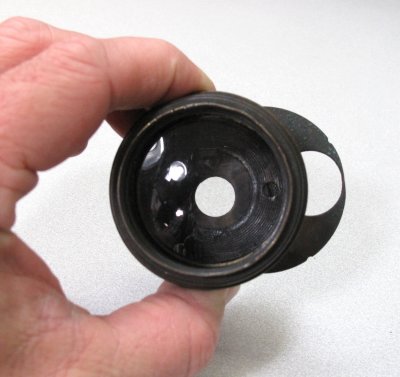
Figure 3: Design of a French Landscape lens (left) and an actual lens (center and right). Note the mechanical aperture wheel. The aperture was changed by rotating the wheel which had various size openings.
Chevalier’s French Landscape lens demonstrated that a doublet of two lenses of different dispersion cemented together could correct chromatic aberration to a significant degree.
The Prize of 1840
The French Landscape Lens did produce acceptable images for early photographers, but it had a few weak points. First among these was that the lens was f/15 aperture at its maximum and really performed better at f/22 or so. Combined with the chemical processes used in the early cameras, exposure times of about 30 minutes in good sunlight were the norm with this lens. That was OK if you had a really good tripod and were taking pictures of a landscape, but what people wanted were portraits. Unless you were taking portraits of a corpse (which was done with some frequency in those days, actually), 30 minute exposures just weren’t cutting it. So in 1840, the French Society for the Encouragement of National Industry organized a contest and offered a prize for the person developing the best wide aperture lens.
Chevalier was all over this and proceeded to experiment with different combinations of elements. He found if he added a second achromat to the first it would further concentrate light, and apertures of about f/6 were obtained, six times faster than his original lens. In a stroke of brilliance, he also put the second element in a removable section of the lens so that it could be reversed, changing the focal length considerably—very nearly a precurser to the zoom lens.
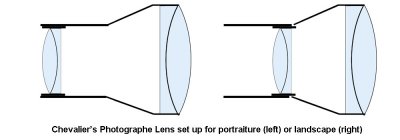
Figure 4: Design of Chevalier’s Photographe a Verres Combines
He submitted his “Chevalier’s Photographe a Verres Combines” for consideration of the prize, pretty confident that he had a killer lens and, as a French homeboy, the prize was his. In fact, it appeared nobody else was going to even enter the contest: competing with the world’s top lens designer, who lived in Paris, in a contest judged by Frenchmen has all the appeal of invading Russia in winter. The chance of success is pretty much none.
So, of course, this Austrian guy named Joseph Petzval decided to enter the contest (Well, actually, he wasn’t Austrian. But he was a mathematics professor at the University of Vienna, so he hung out with mostly Austrians. He was originally from the town of Pest in what is now Hungary. It would be years before Pest got together with the neighboring town of Buda and said, “Hey, we both have stupid names, so lets join up and become Budapest.”) Anyway, Joseph didn’t have the slightest clue about designing lenses, but like all math geeks, he figured if he just had sufficient computing power, he could do it all on paper.
Of course, this was 1840 and Apple hadn’t started up yet, so he couldn’t just order the new iMac. Instead, he did what most computer guys do when they need more power: he went to the military and asked for some supercomputer time. Archduke Ludwig, General of the Austrian Army (and therefore sworn enemy of all things French) ordered that “Corporals Loschner and Haim and eight gunners skilled in computing” be placed at Petzval’s disposal (Kingslake, 1989). So Petzval, armed with the world’s first parallel computer in the guise of 10 Austrian artillerymen, set out to do some scientific lens designing.
In about 6 months, Petzval had discovered the mathematical formula that describes spherical curvature in a lens, Petzval’s Sum, as well as formulas for refraction and certain aberrations. He developed, on paper, the design for two lenses. The first, later known as Petzval’s Portrait Lens, used separated, rather then cemented (as in Chevalier’s lens), rear elements, which, Petzval’s calculations showed, would correct for spherical aberration and coma. (The design for the second lens was tucked away in a drawer, but we’ll get back to it a bit later.) Petzval took his designs to his good friend, the Vienna optical instrument maker Peter Wilhelm Friedrich von Voigtl?nder, to produce and submitted it to the French Society for evaluation.
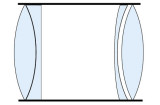
Figure 5: Design of Petzval’s Portrait Lens. Note the small air space between the rear elements, a subtle but significant difference from Chevalier’s lens.

Figure 6: Actual Petzval’s Portrait lens (small example) next to Canon 85mm f/1.8. Note the rack-and-pinion focusing knob.
The committee carefully evaluated both lenses over a 6 month period. While we don’t have their actual findings, it’s clear that the Petzval Portrait was sharper, had less distortion, could expose an image in about 10 seconds (1/2 the time of Chevalier’s lens), and was easier to focus. The Chevalier lens had the cool reversible focal length back thing and, although the lens wasn’t very good, it had Paris, France stamped all over it. And the Committee was French and Petzval was Austro-Hungarian, so they awarded Chevalier a Platinum Medal and prize, skipped over gold entirely, and gave Petzval a Silver Medal and a hearty handshake.
But history, and the photographers of the day, judged rather differently. Chevalier continued to advertise and make his Phtographe a Verres Combines for the next 20 years, but it’s a good thing he kept the microscope business to fall back on. The lens was a total failure and the few copies he sold were probably on the 1840s equivalent of eBay as “camera and two lens set, take all picture you ever want. Plus free tripod as gift.”
The Petzval Portrait lenses sold thousands of copies and remained in production until the 1920s. But while Petzval won the battle he lost the war. His “close personal friend” Frederich von Voigtlander made a handshake agreement to produce an all-metal camera that used a Petzval lens for a one-time fee of 2,000 Guldens (I have no idea how much that is in dollars, but apparently not too much, at least judging by Petzaval’s later feelings about the transaction). Voigtlander decided that also covered his producing and selling Petzval Portrait lenses and proceeded to sell some 60,000 copies at a couple of hundred Guldens per, so he made out like the bandit he was. Petzval sued Voigtlander for fraud in 1845. Voigtlander, realizing Petzval only held Austrian patents, moved his plant to Germany and manufactured the lenses there.
The two remained bitter enemies and in 1856 Petzval commissioned Deitzler Optical Works to build the second lens he had designed (remember that other lens), a landscape lens called the Dialyte. When Petzval’s house was burglarized in 1859 and all of his optics manuscripts stolen, he blamed Voigtlander. He may have been correct, because Voigtlander soon began producing an identical lens to the Dialyte, the Voigtlander Orthoskop. Voigtlander was a dominant lensmaker for many years and became incredibly rich. Petzval became so embittered that he stopped all work in optics. He eventually left Vienna and lived as a hermit in a monastery. (Really, he did. I wouldn’t make that up. Mostly because I wouldn’t have thought of it. That’s just too good of a story.) He died nearly penniless in 1891.
Petzval did get one more parting shot at the French Committee who denied his prize. Petzval’s Portrait Lenses were sold all over the world, but by the 1850s, with the advent of making multiple prints from negatives, more were sold in Paris (home of Chevalier) than anywhere else. Why Paris? Because French laws made it one of the few places in the world that “Artistic” (pronounced pornographic) photographs could be reproduced. The French Postcard (so called because of its size, it was illegal to mail them) is said to have supported more photographers than all other image types combined during the late 1800s. Some of the great early photographers, including Reijlander and Eadweard Mubridge, largely made their living by producing these pornographic prints.
Both Chevalier’s and Petzval’s Portrait lens demonstrated that additional elements could gather more light, reducing the effective aperture of the lens. The Petzval lens also demonstrates that adding additional air-glass interfaces (rather than cementing the two elements in the rear) allowed correction of more aberrations, increasing sharpness.
The Rapid Rectilinear Lens
In the 1860s photographers still used largely the French Landscape Lens and Petzval’s Portrait lens, along with a number of lesser and not very adequate lenses. Petzval’s lens was horribly soft in the corners (leading to the popularity of oval frames), and all the lenses of the day exhibited distortion, limiting the ability of photographers to capture architectural images. What they wanted most was a reasonably wide aperture lens that was free of distortion.
Two separate lensmakers, John Dallmeyer in England and Dr. H. A. Steinheil in Germany, both solved the problem in identical ways about the same time in 1866. The lenses used two doublets of different refractive power but similar dispersive power, placed symmetrically around a central stop (light baffle). All the elements were meniscus-shaped with positive elements in the center and negative elements away from center (A number of similar lenses had been tried, but with the order of those elements reversed.).

Figure 7: Design of Rapid Rectilinear Lens (courtesy Wikepedia Commons)
Steinheil had a doctorate degree, worked with von Seidel (the physicist who had documented the different types of lens abberations) and had designed his lens mathematically, so he was certain Dallmeyer had stolen his ideas and fired off the ritual (for the time) letters and press releases calling out Dallmeyer as a thief. Dallmeyer was a simple lensmaker, but smart enough to marry his employer’s daughter so he inherited the company (Ross Optical). And while not formally educated, he had an excellent reputation as a lensmaker.
When the dust settled, it appeared Dallmeyer had experimented with various combinations and hit on the same idea through practical experience that Steinhill had discovered through precise calculations. Both of them received patents and manufactured and marketed their lenses. (Dallmeyer perhaps a bit more successfully probably because Rapid Rectilinear is a much cooler name than Aplanat).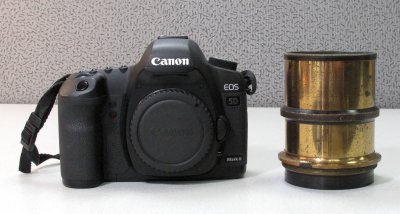
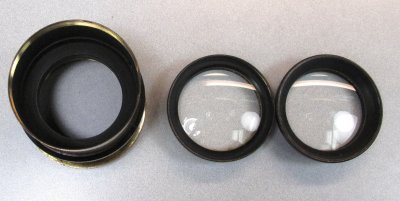
Figure 8: A Rapid Rectilinear Lens next to a Canon 5D (above) and disassembled showing the two identical glass elements (below).
Both Dallmayer’s Rapid Rectilinear and Steinhill’s Aplanat were hugely popular. By changing the composition of the glass used in the elements and the distance between them, the lenses could be made wide angle, standard, or short telephoto. In all forms it was remarkably free of distortion and had fairly wide (f/6 to f/8) aperture. It remained in production, under numerous names, for nearly 60 years.
The Rapid Rectilinear Lens demonstrated that symmetrical doublets around a central stop were nearly free from distortion, had a reasonably flat field, and could be used at wide aperture.
And Then?
Not much for quite a while. There were other lenses made, of course. Most were minor variations on the Petzval Portrait and the Rapid Rectilinear lenses, either unsuccessful attempts to improve the lenses themselves, or more often simply efforts to work around patents.
Major jumps in lens quality wouldn’t occur until Ernst Abbe and Joseph Schott formed the Schott Glass works and developed a system of measuring and categorizing the refractive and dispersive properties of various glass types known as Abbe’s number. Together they developed the dense barium crown glass that was needed for further improvement in lens design, but this wouldn’t become available until nearly 1890. When it did, the company they worked for, a small microscope maker named Carl Zeiss & Co. would move to the forefront of photographic lens manufacturing. But that’s an article for another day.
In the meantime, glance at the schematics of these simple, classic lenses again before you leave this article. If you look at the schematics of some modern designs, you’ll see their ancestry can be traced back, at least in part, to these lenses. You’ll never find a modern lens that doesn’t contain a meniscus element and and achromatic group, for example. And you’ll see Petzval’s small air space between elements in many modern lenses for just the same purpose: to allow the designer to reduce aberrations more accurately than a cemented group would. And while it’s often hidden within other elements, you can find symmetrically opposed groups, like those of the Rapid Rectilinear, in the design of more than a few modern lenses.
References
- http://niepce.house.museum/pagus/invus4.html
- http://encyclopedia.jrank.org/articles/pages/1015/Evolution-of-the-Photographic-Lens-in-the-19th-Century.html
- http://image.eastmanhouse.org/files/GEH_1961_10_05.pdf
- Kingslake, Rudolph: A History of the Photographic Lens. Academic Press, London, 1989.
- http://en.wikipedia.org/wiki/Joseph_Petzval
- http://www.camerapedia.org/wiki/Voigtl?nder
Author: Roger Cicala
I’m Roger and I am the founder of Lensrentals.com. Hailed as one of the optic nerds here, I enjoy shooting collimated light through 30X microscope objectives in my spare time. When I do take real pictures I like using something different: a Medium format, or Pentax K1, or a Sony RX1R.

Pingback: A little lens history – Shutterbugging dot Net()
Pingback: Effective focal lengths with full and small frame sensors - Page 2()
Pingback: LensRentals.com - The Showman, the Sheriff, and the First Cameras()